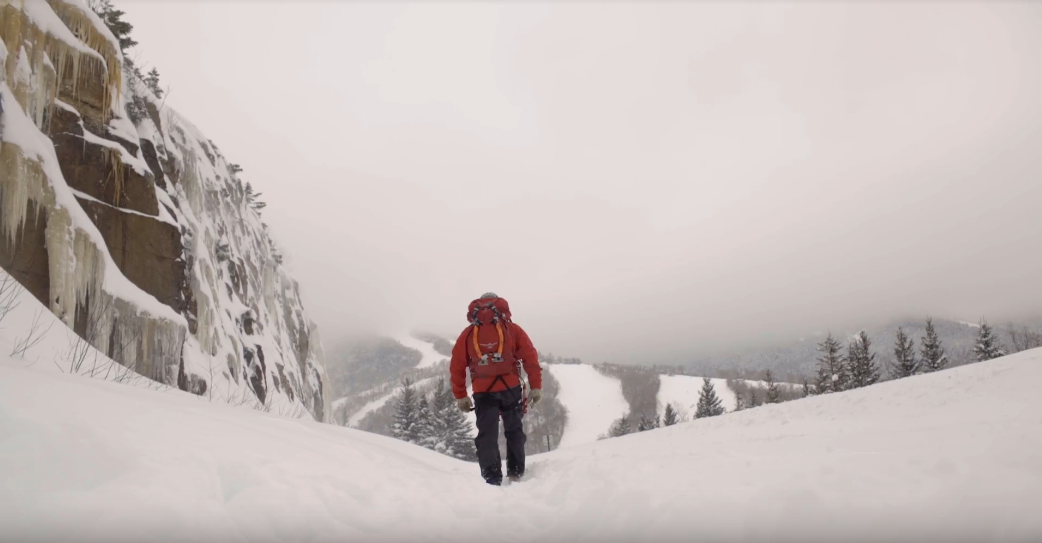
The White Mountains of New Hampshire is home to diverse and sometimes challenging weather. Mount Washington on the eastern side of the White Mountains is home to the most extreme weather observatory on Earth. First opened in 1870, the Mt. Washington Observatory has experienced some crazy weather, like below zero temperature in the height of summer and wind gusts as high as 231 mph, which is equivalent to an EF5 tornado or a Category 5 hurricane!
While the weather in the Western White Mountains isn’t as extreme, it’s not uncommon to experience all four seasons in a single hour in the White Mountains, especially if you’re heading above treeline. The Western White Mountains is home to an abundance of incredible year-round outdoor activities, and just because Mother Nature can’t make up her mind, it’s important to be prepared for all different weather events on your adventures.
Winter
The Western White Mountains can be cold. A couple of years ago, the thermometer read negative 20 degrees without the wind chill for several days in a roll. While your first thought might be to skip the ski slope for the day in favor of drinking hot cocoa (or locally brewed beers!) by the fireplace, if you dress for the weather, you won’t even feel the cold!
Justin Walsh, the Operations Manager for Burgeon Outdoors, is no stranger to extreme weather as a mountaineering guide. He says, “surviving the cold depends on your ability to use layers to regulate your temperature. Clothes don’t make you warm. You make clothes warm. Or another way to put it – if your body is like a furnace in your house and your clothes are the insulation.”
The key for dressing for the cold (or really any other time of the year) is layers! Modularity allows you to adjust your “insulation” to be appropriate at any level of exposure and any level of bodily activity. You’ve probably heard this before, but the old adage is true – cotton kills. Avoid wearing cotton and instead choose items made from moisture-wicking materials such as wool, polyester, or Tencel.
When wearing layers, you should have a base layer, such as long underwear, a middle layer of fleece or light down jacket, and then finally a water-resistant outer layer. Need some suggestions? Check out what Field and Stream recommend here, including the Burgeon Outdoor Flume Base Layer. And don’t forget about your head, hands, and feet! Hats are a great way to keep your head warm. In extreme cold and wind, you’ll likely want a balaclava to keep your face warm, too. Mittens are always warmer than gloves but choose what works best for you. If you’re playing in the snow, you’ll want waterproof gloves. Your feet will be happy with thick non-cotton socks, such as Smartwool. Warming packets can also be used on your hands and feet on those bitter New England winter days.
And don’t forget about eyewear! Goggles are great for winter sports as they stay on your head better and help protect your eyes from potential injuries from tree branches or ski poles. On those bring sunny days, sunglasses are a must! Snow makes everything brighter.

Spring
Spring in the Western White Mountains can vary widely from feeling like a cold January winter day to a hot summer day. And that’s all in the same week! Spring in the mountains always starts with New England’s unofficial fifth season – mud season. As the snow melts in the mountains, the ground turns to mud. You’ll definitely want some tough rain boots and waterproof hiking boots if you’re hitting the trails. Snow in the high peaks might not melt well into June and July. If you’re hiking above treeline, remember to bring layers and be prepared for winter-like weather. Crampons or ice traction devices are a must for safety!
As spring proceeds and summer slowly approaches, the black flies and bugs start to emerge from their winter sleep. Bring bug spray and dress to repel the bugs! This might mean wearing long pants and long sleeves to keep them from biting your skin. As the sun gets brighter and hotter and you begin to wear less clothing, remember the sunscreen!
Summer
Don’t blink! Summer doesn’t last long in the Western White Mountains, but those few glorious months are meant to be enjoyed in the sun. While the mercury can climb quite high in the months, the White Mountains remain relatively moderate in the mountains due to the higher elevations. During the warmer summer months, you’ll likely want to don shorts and a t-shirt. Aim to wear moisture-wicking and UFP-protecting clothing items to help protect your skin and stay cool.
The black flies and mosquitoes are notoriously bad in the summer. That means insect repellent is your new best friend. If the bugs really enjoy your blood type, wearing long sleeve shirts and long pants might be the best option for you. Nylon and polyester are fabrics that mosquitoes have a hard time biting through, and avoid dark or bright fabrics as they can attract insects.
Temperatures can drop quickly the higher you climb in the mountains or after dark, so it’s important to pack layers, such as a fleece and warm socks. A hat provides essential sun protection for your face and neck. If you find yourself hiking on one of those rare 90-degree days, a bandana or neck gaiter is a great item to keep in your backpack as you can dunk it in water and wear it around your neck or head to help cool off. If your outside hiking, biking, or enjoying the watersports, remember to pack plenty of water to keep you hydrated. A good rule of thumb is to drink about a half-liter of water per hour of moderate activity.
Fall
Fall is one of the busiest times of the year for the Western White Mountains as the weather is great and the leaves are turning into a kaleidoscope of colors. In September, you’ll find that the temperatures during the day are often warm enough to wear shorts, but you’ll want to change into long pants and a sweater at night. Fall is a season of layers, especially as we get closer to winter. A fleece or a light jacket is a must, and eventually, you’ll want to break out lightweight gloves for those early morning hikes when the frost starts sticking around long after you finished your morning coffee.
Like winter, fall in the Western White Mountains can widely varied, and it’s best to be prepared for any weather from 70 degrees and sun to 20 degrees and snow. If you forget your favorite hat at home, Lincoln is home to several shops where you can pick up all your favorite gear. Rodgers Ski & Sport has all the cold-weather gear from your favorite brands. For locally made technical outdoor apparel, check out Burgeon Outdoor at the Village Shops in Lincoln.
Dress Your Best for All Season
The Western White Mountains is beautiful year-round with the right clothing. Bundle up for winter or enjoy the sun during the summer. Whatever you choose, remember that Mother Nature may change her mind in 20 minutes, so bring options!
For state-wide information, head to VisitNH.gov





